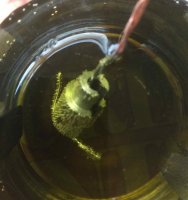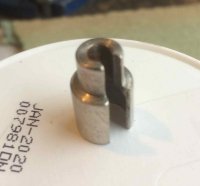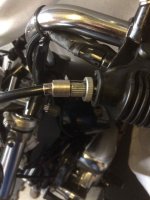It's been over a year since I plated my parts, so time for a longevity update followed by DEEP THOUGHTS on DIY plating.
All of my parts have spent the last year in a completely non-climate controlled space. Other than being protected from rain, they may as well have been outside.
The above part has held up well.
However, there is some red iron oxide rust on the back. To some degree or another, almost every part that I have plated get these little rust spots. On this piece, and in the following pictures, the rust appeared very quickly, like within 10 days. However, the good news is that it never progressed beyond that 10 days. So, I have to conclude that the plating somehow did not "take" in the rust spot areas, while the surrounding surfaces resist rust well.
These have held up very well. Probably my most successful pieces. The marks are pits, and the plating seems to have gotten into the pits and protected them.
The other side of this piece, which is the side that shows, plated way better than this side.
This side of this piece was pretty successful. The pits, cuts, and marks all got plated and protected.
However, the back side has a big rust track along the bend. I plated this piece several times, trying slightly different parameters each time, but I always got rust here. Most vexing.
Here are my Deep Thoughts regarding DIY plating. If you go back to post #2 in this thread, and watch the video, that guy is plating in a vinegar solution. Vinegar is acetic acid, and like all acids (with the possible exception of phosphoric acid), it etches steel. Think about it, your part is in a vinegar solution which is removing material, while you are simultaneously trying to deposit nickel on that material. Logic tells me that something has to give.
I got poor results when I followed the video instructions to a tee. He uses a weak nickel solution and a low electric current. I concluded that you need to really hit the part hard, getting a layer of plate on it as quickly as possible, before the ascetic acid can remove much material.
So, that's what I did. I made a very dark green nickel solution, and I used a more powerful power supply. I also went to a much smaller container, to "concentrate" the voltage, so to speak. And, I started getting much better results.
If your voltage is too high, the plating will flake. I tried beginning the plating with a high voltage to quickly "cover" the bare metal and prevent etching, and then I'd switch to a lower power supply to build up the nickel thickness. This seemed to work pretty well.
My results are okay, but I wish they were perfect. Others seem to be getting better results, either that or they're lying, and I'd like to know what they're doing that I'm not.
I spent a lot of time researching commercial plating, trying to find out if they are plating in acid solutions. I never found my answer, but I suspect not. I also looked at the Caswell nickel plating kit instructions. They use distilled water, but I don't really know what the chemistry of their process is.
I'd like to be plating in a non-acid solution, if that's possible.




